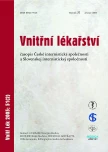Heparin-induced thrombocytopenia in a patient with left main coronary artery stenosis
Authors:
J. Hirmerová
Authors‘ workplace:
II. interní klinika Lékařské fakulty UK a FN, Plzeň, přednosta doc. MUDr. Jan Filipovský, CSc.
Published in:
Vnitř Lék 2005; 51(2): 231-237
Category:
Case Reports
Overview
The article describes a case of a 75 year old female patient with hypertension and chronic atrial fibrillation, admitted for shortness of breath and chest pain. Coronarography revealed a significant stenosis of the left main coronary artery. The patient was indicated to coronary artery bypass grafting. During the stay, low molecular weight heparin had been applied. In the third week the platelet count fell down markedly and several days later, heparin necrosis developed in a place of subcutaneous heparin application in abdominal wall. Laboratory assays confirmed the presence of the antibodies against the heparin/ platelet factor 4 complex. Thus the heparin-induced thrombocytopenia (type II) was diagnosed, the relatively rare complication of heparin therapy, associated with hypercoagulable state. Low molecular weight heparin was quit. Platelet count recovered slowly, heparin necrosis healing took several months. Heparin was considered to be contraindicated, so the cardiac surgery was not feasible. Because of borderline significance of the stenosis conservative approach was chosen. Since discharge, the patient has been followed on outpatient basis and there has been no need to consider the invasive treatment again. The special features of the case are discussed, as well as the diagnostics and treatment of heparin– induced thrombocytopenia and the possibilities of invasive procedure using nonheparin anticoagulant.
Key words:
heparin-induced thrombocytopenia – left main coronary artery stenosis – hypercoagulable state – anticoagulant therapy
Sources
1. Amiral J, Peynaud-Debayle E, Wolf M et al. Generation of Antibodies to Heparin-PF4 Complexes without Thrombocytopenia in Patients Treated with Unfractionated or Low-molecular-weight Heparin. Am J Hematol 1996; 52: 90–95.
2. Arepally G, Reynolds C, Tomaski A et al. Comparison of PF4/heparin ELISA Assay with the 14C-Serotonine Release Assay in the Diagnosis of Heparin-Induced Thrombocytopenia. Am J Clin Pathol 1995; 104: 648–654.
3. Girolami B, Prandoni P, Stefani PM et al. The Incidence of Heparin-Induced Thrombocytopenia in Hospitalized Medical Patients Treated with Subcutaneous Unfractioned Heparin: a Prospective Cohort Study. Blood 2003; 101: 2955–2959.
4. Greinacher A. Recombinant Hirudin for the Treatment of Heparin-Induced Thrombocytopenia. In: Warkentin TE, Greinacher T. Heparin-Induced Thrombocytopenia. 2nd ed. New York: Marcel Dekker 2001: 349–380.
5. Greinacher T, Warkentin TE. Treatment of Heparin-Induced Thrombocytopenia: An Overview. In: Warkentin TE, Greinacher T. Heparin-Induced Thrombocytopenia. 2nd ed. New York: Marcel Dekker 2001: 291–322.
6. Harrison L, Johnston M, MassicotteMP et al. Comparison of 5–mg and 10-mg Loading Doses in Initiation of Warfarin Therapy. Ann Intern Med 1997; 126: 123–132.
7. Chong BH, Magnani HN. Danaparoid for the Treatment of Heparin–Induced Thrombocytopenia. In: Warkentin TE, Greinacher T. Heparin-Induced Thrombocytopenia. 2nd ed. New York: Marcel Dekker 2001: 323–347.
8. Chong BH. Heparin-induced Thrombocytopenia. J Thromb Haemost 2003; 1: 1471–1478.
9. Lee DH, Warkentin TE. Frequency of Heparin–Induced Thrombocytopenia. In: Warkentin TE, Greinacher. Heparin–Induced Thrombocytopenia. 2nd ed. New York: Marcel Dekker 2001: 87–121.
10. Lewis BE, Hursting MJ. Argatroban Therapy in Heparin-Induced Thrombocytopenia. In: Heparin-Induced Thrombocytopenia. 2nd edition. New York:
Marcel Dekker 2001: 381–407.
11. Madei W, Klieser HP, Hoerauf K. Heparin-Induced Thrombocytopenia as the Cause of Persistent Bleeding after Pacemaker Implantation. Dtsch Med Wochenschr 1999; 124: 487–490.
12. Novotný J, Konvičková L. Heparinem indukovaná trombocytopenie. Vnitř Lék 1998; 44: 282–287.
13. Pötzsch B, Klövekorn WP, Madlener K. Use of Heparin during Cardiopulmonary Bypass in Patients with a History of Heparin-Induced Thrombocytopenia. N Engl J Med 2000; 343: 515.
14. Pötzsch B, Madlener K. Management of Cardiopulmonary Bypass Anticoagulation in Patients with Heparin-Induced Thrombocytopenia. In: Warkentin TE, Greinacher T. Heparin-Induced Thrombocytopenia. 2nd ed. New York: Marcel Dekker 2001: 429–444.
15. Rice P, Dace S, McMullin MF et al. Heparin-Induced Thrombocytopenia Causing Life-Threatening Postoperative Haemorrhage. Br J Clin Pract 1996; 50: 404–405.
16. Verma AK, Levine M, Shalansky SJ et al. Frequency of Heparin-Induced Thrombocytopenia in Critical Care Patients. Pharmacotherapy 2003; 23(6): 745–753.
17. Warkentin TE, Greinacher A. Laboratory Testing for Heparin-Induced Thrombocytopenia. In: Warkentin TE, Greinacher T. Heparin-Induced Thrombocytopenia. 2nd ed. New York: Marcel Dekker 2001: 231–269.
18. Warkentin TE, Kelton JG. Temporal Aspects of Heparin–Induced Thrombocytopenia. N Engl J Med 2001; 344: 1286–1292.
19. Warkentin TE, Levine MN, Hirsch J et al. Heparin-Induced Thrombocytopenia in Patients Treated with Low-molecular-weight Heparin or Unfractionated Heparin. N Engl J Med 1995; 332: 1330–1335.
20. Warkentin TE, Sheppard JAI, Horsewood P et al. Impact of the Patient Population on the Risk for Heparin-Induced Thrombocytopenia. Blood 2000; 96: 1703–1708.
21. Warkentin TE. Clinical Picture of Heparin-Induced Thrombocytopenia. In: Warkentin TE, Greinacher T. Heparin-Induced Thrombocytopenia. 2nd edition. New York: Marcel Dekker 2001: 43–86.
22. Warkentin TE. Heparin-Induced Thrombocytopenia. In: Kitchens CS, Alving BM, Kessler CM. Consultative Hemostasis and Thrombosis. Philadelphia: Elsevier Science 2002: 355–372.
23. Warkentin TE. History of Heparin-Induced Thrombocytopenia. In: Warkentin TE, Greinacher T. Heparin-Induced Thrombocytopenia. 2nd ed. New York: Marcel Dekker 2001: 1–18.
24. Warkentin TE. Thrombotic Complications of Anticoagulant Therapy. In: Colman RW, Hirsch J, Marder VJ et al. Hemostasis and Thrombosis. Basic Principles and Clinical Practice. 4th ed. Philadelphia: Lippincott Williams Wilkins 2001: 1371–1382.
Labels
Diabetology Endocrinology Internal medicineArticle was published in
Internal Medicine

2005 Issue 2
Most read in this issue
- Pulse pressure in the young population detected by ABPM and it’s relation to metabolic and anthropometric parameters
- Tumor lysis syndrome
- Congenital adrenal hyperplasia, defect of 17α-hydroxylase as a rare cause of hypertension and hypocalaemia
- Personal experience with the origin and duration of spontaneous remission in adult type 1 diabetics
